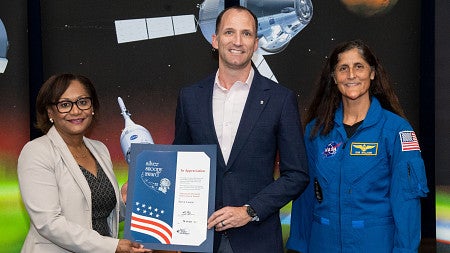
NASA recognized a University of Oregon alumnus for his impactful research on the health of astronauts in space with an award depicting NASA’s own safety mascot, the beloved cartoon dog Snoopy.
Steven Laurie, Ph.D. is the technical lead scientist for KBR (Kellogg, Brown & Root) in the cardiovascular and vision laboratory at Johnson Space Center, and received the Silver Snoopy award in May. The prestigious pin is given to less than 1 percent of the aerospace program workforce, according to NASA. Each Silver Snoopy lapel pin also flies in space before it is given to the chosen scientist. The pin Dr. Laurie received flew aboard the SpaceX DM2 Flight from May 30, 2020, through August 1, 2020. While docked to the International Space Station, it traveled more than 25 million miles.
The Silver Snoopy is the astronauts' own award for outstanding performance and contribution to flight safety, according to NASA, and thus an astronaut presents the award to each scientist. Astronaut Suni Williams presented the pin to Dr. Laurie, who is a graduate of the Department of Human Physiology, at his award ceremony.
“It’s certainly an honor to be recognized, especially since it's the only award where crew members directly recognize us for the work that we do,” said Dr. Laurie.
The Silver Snoopy originates from a long history connecting Snoopy to NASA. Snoopy’s official association began in 1968, when NASA approached Peanuts creator Charles Schulz with an idea to improve the safety record of NASA employees before its first lunar mission. In 1969, the crew of Apollo 10 chose to nickname their command and lunar modules Charlie Brown and Snoopy, respectively, according to the Charles M. Schulz Museum. With the newly established safety award bearing the character’s likeness, Snoopy has served as NASA’s safety mascot for over 50 years.
Dr. Laurie and his fellow scientists perform research on the cardiovascular and ocular health of astronauts while they reside on the International Space Station. The team creates protocols for how to measure astronauts’ heart and eye health — once astronauts agree to participate, the team begins preliminary health research on the ground.
After the astronauts arrive at the International Space Station, Dr. Laurie and his team remotely guide the astronauts through performing a variety of medical tests and exams on each other, from imaging the back of the eye to performing ultrasounds.
“The astronauts pick up the microphone and they call down to us, and all of a sudden I'm talking to space,” said Dr. Laurie. “It's always very exhilarating.”
Once these tests are completed, the data are sent back to Earth where Dr.Laurie and his team work to analyze and interpret the results and monitor the long-term health of each astronaut involved.
One concern Dr. Laurie monitors for is swelling in the optic nerve head, which has been shown to lead to nerve damage and blindness in people on Earth. That hasn’t happened in space yet, but devices like the eye cameras, as well as machinery to measure pressure in the eye, blood pressure and heart rate, help ensure that astronauts’ physical health stays optimal in the weightless environment.
Dr. Laurie graduated from UO in 2012 with a doctorate in human physiology. With his mentor, Professor of Human Physiology Andrew Lovering, Dr. Laurie studied lung function in high altitude and other extreme environments. His work with Lovering laid the foundation for his current work with NASA and the International Space Station.
“I didn't specifically train to work with astronauts or study spaceflight, but the training that I received in the Department of Human Physiology, both from the mentors and the curriculum I studied, is really what has led me to where I am today,” said Dr. Laurie. “It has opened up a lot of avenues for me, as my studies allowed me to be successful in studying astronauts in space.”
—By Alyson Johnston, College of Arts and Sciences
